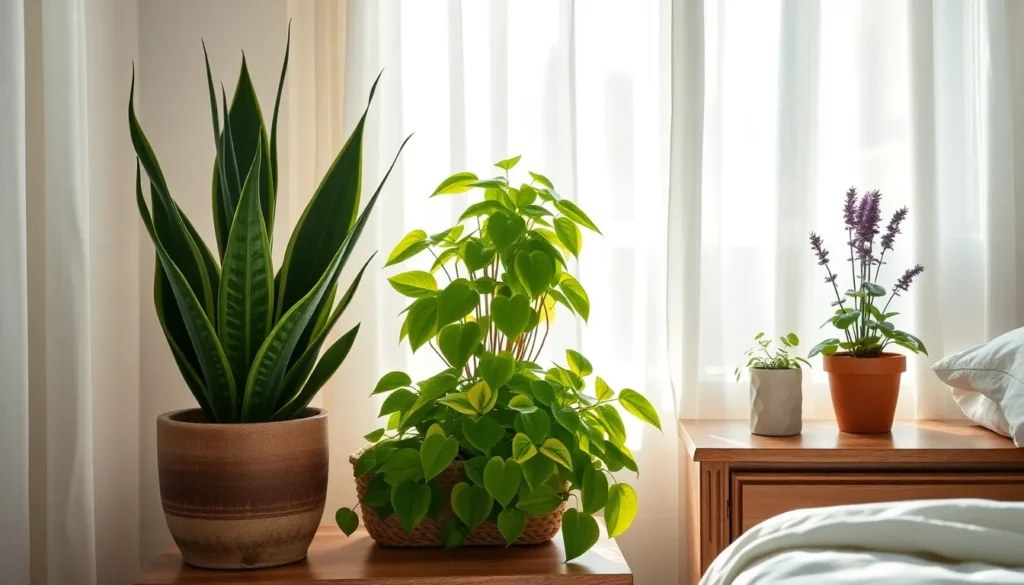Welcome to the lush world of indoor gardening, where even the smallest green companion can transform your bedroom into a serene sanctuary. Whether you’re a beginner just starting to explore the joys of nurturing plants or an experienced gardener seeking new leafy friends, this guide promises to inspire and equip you with the knowledge to cultivate a thriving indoor oasis.
In this carefully curated selection of the best indoor plants for your bedroom, you’ll discover varieties that are not only visually captivating but also remarkably easy to care for. These plants offer more than just aesthetic appeal; they purify the air, boost your mood, and even improve your sleep quality, making your bedroom a healthier, happier place to unwind.
Imagine waking up each morning to the gentle embrace of nature, confident in your ability to nurture these green wonders. This guide is designed to give you the confidence and know-how to succeed, ensuring that your indoor garden flourishes and brings endless joy to your daily life.
Peace Lily (Spathiphyllum wallisii)

The Peace Lily, known scientifically as Spathiphyllum wallisii, is a popular choice for bedroom decor because of its elegant appearance and ability to purify the air. These plants thrive in low-light conditions, making them perfect for rooms that don’t receive much natural sunlight.
When it comes to watering, Peace Lilies prefer to be kept moist but not soggy. It’s best to water them when the top inch of soil feels dry to the touch, which usually means about once a week.
To encourage lush growth, use a well-draining potting mix and consider adding some perlite to improve aeration. Feeding your Peace Lily with a balanced liquid fertilizer every 6-8 weeks during the growing season can also promote vibrant foliage.
Advanced gardeners might appreciate the challenge of propagating Peace Lilies through division. Simply separate the root clumps carefully and replant them in their own pots to create new plants.
Keep in mind that Peace Lilies are sensitive to chlorine and fluoride found in tap water. To avoid leaf browning, use filtered or distilled water, or let tap water sit out overnight before using it on your plant.
Spider Plant (Chlorophytum comosum)
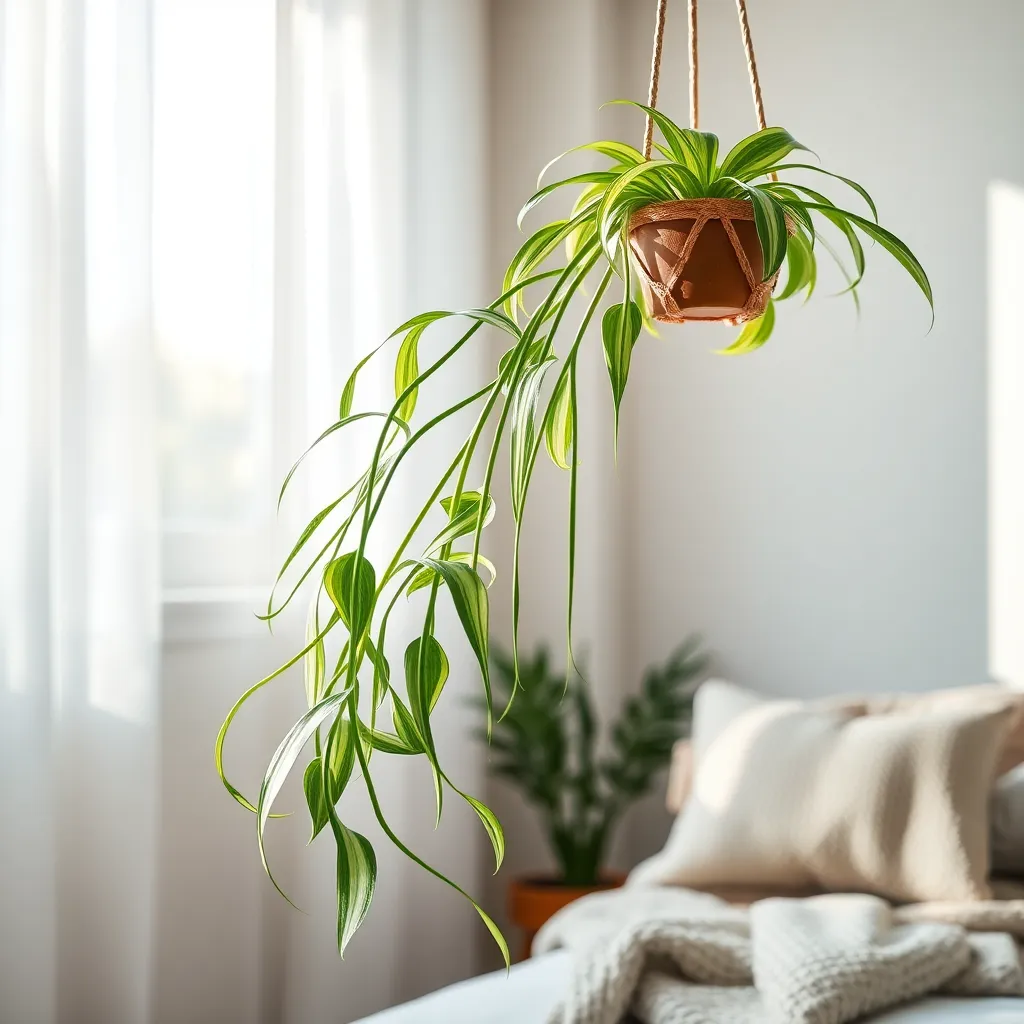
The Spider Plant (Chlorophytum comosum) is a favorite among indoor gardeners for its striking appearance and ease of care. This plant thrives in indirect sunlight, making it perfect for brightening up a bedroom corner without the need for direct sunlight.
To ensure your Spider Plant thrives, pot it in a well-draining soil mix, such as a combination of peat, pine bark, and perlite. Water the plant moderately, allowing the top inch of soil to dry out between waterings to prevent root rot.
Spider Plants are known for their resilience and can adapt to a range of temperatures, ideally between 65-75°F (18-24°C). They are also excellent air purifiers, removing toxins like formaldehyde, which makes them beneficial for bedroom air quality.
For those looking to propagate, Spider Plants produce baby offshoots or “spiderettes” that can be easily rooted in water or soil. Trim these offshoots when they develop small roots, and you’ll have new plants to share or expand your indoor garden.
Aloe Vera (Aloe barbadensis miller)
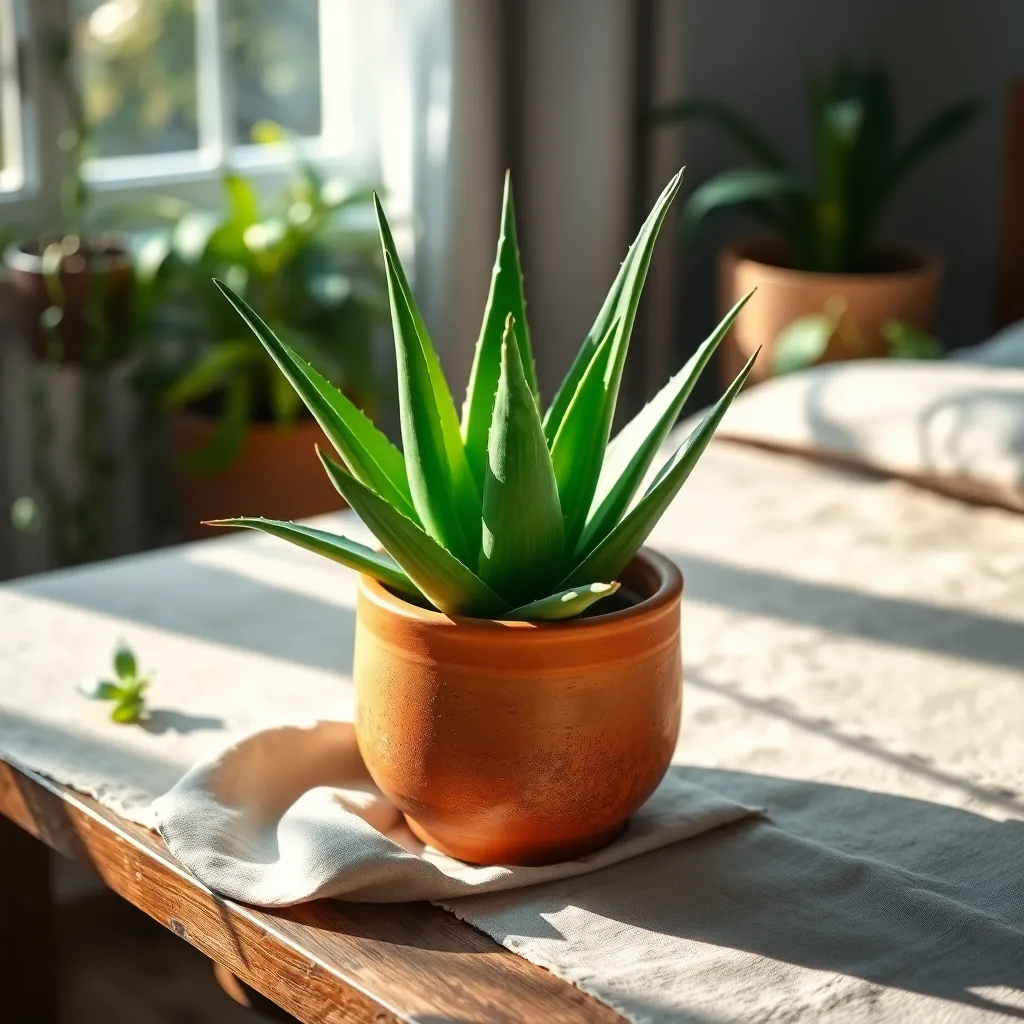
Aloe Vera (Aloe barbadensis miller) is a popular choice for bedroom decor due to its low maintenance and air-purifying qualities. This succulent is perfect for beginners, as it requires minimal care and thrives with just a bit of attention.
Place your Aloe Vera in a spot where it can receive bright, indirect sunlight. South or west-facing windows are ideal, but avoid direct sun, which can scorch its leaves.
Water your Aloe Vera sparingly, ensuring the soil dries out completely between waterings. Overwatering is a common mistake, so it’s crucial to let the top inch of soil become dry before giving it another drink.
For optimal growth, use a well-draining potting mix specifically designed for succulents or cacti. This type of soil prevents root rot by allowing excess water to flow through the pot.
Advanced gardeners can propagate Aloe Vera by carefully removing offsets or “pups” from the base of the plant. Simply plant these pups in separate pots with fresh soil, and soon you’ll have new Aloe plants to share or expand your green collection.
English Ivy (Hedera helix)
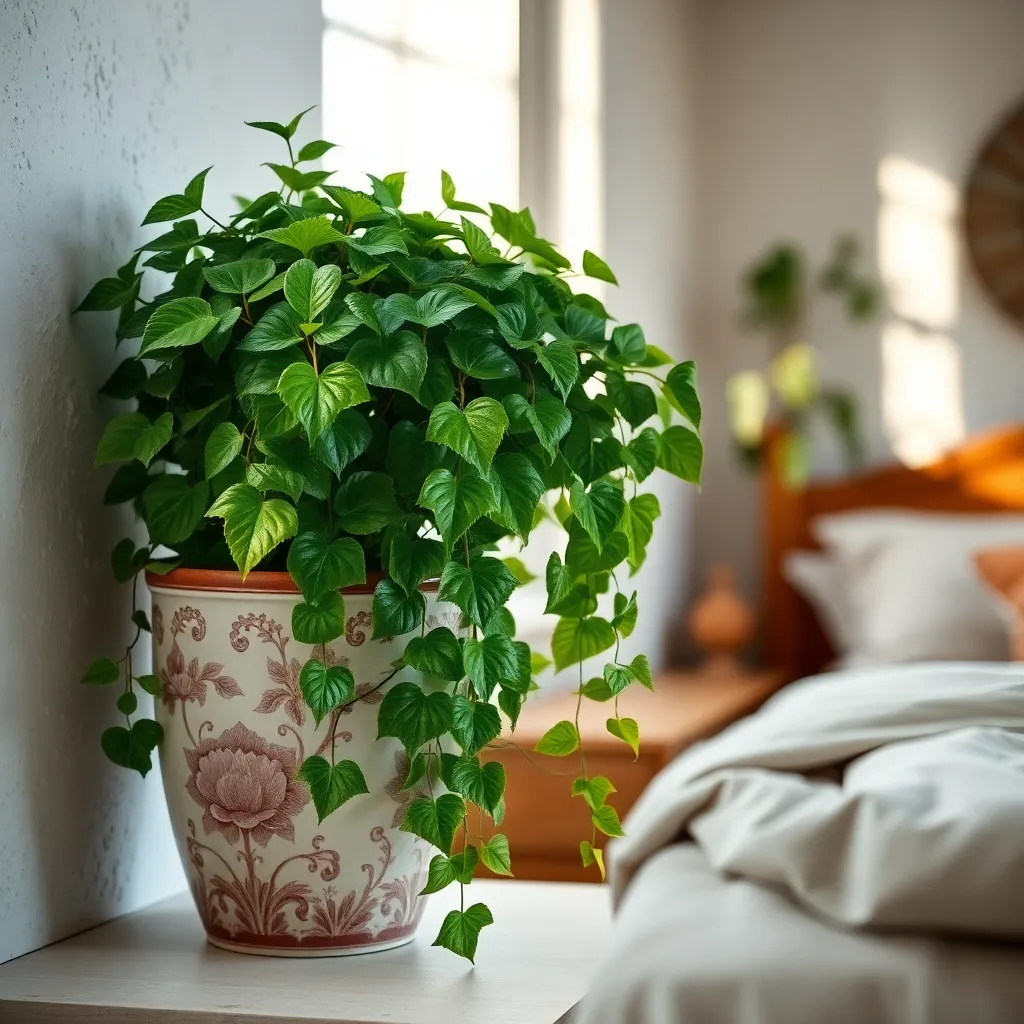
English Ivy (Hedera helix) is an excellent choice for adding a touch of greenery to your bedroom. Known for its air-purifying properties, this plant can help reduce indoor pollutants, enhancing air quality while you sleep.
To thrive indoors, English Ivy prefers bright, indirect light but can tolerate lower light levels, making it versatile for various bedroom settings. Ensure the soil remains consistently moist but not soggy by watering when the top inch of soil feels dry to the touch.
For optimal growth, use a well-draining potting mix, such as one designed for houseplants or a blend of peat moss, perlite, and vermiculite. Fertilize sparingly, feeding with a balanced liquid houseplant fertilizer diluted to half strength every 4-6 weeks during the growing season.
If you’re looking to propagate your English Ivy, take cuttings in spring or summer and root them in water or directly in soil. Regular pruning will not only help maintain its shape but also promote bushier growth, making it a lush addition to your indoor space.
Chinese Evergreen (Aglaonema commutatum)
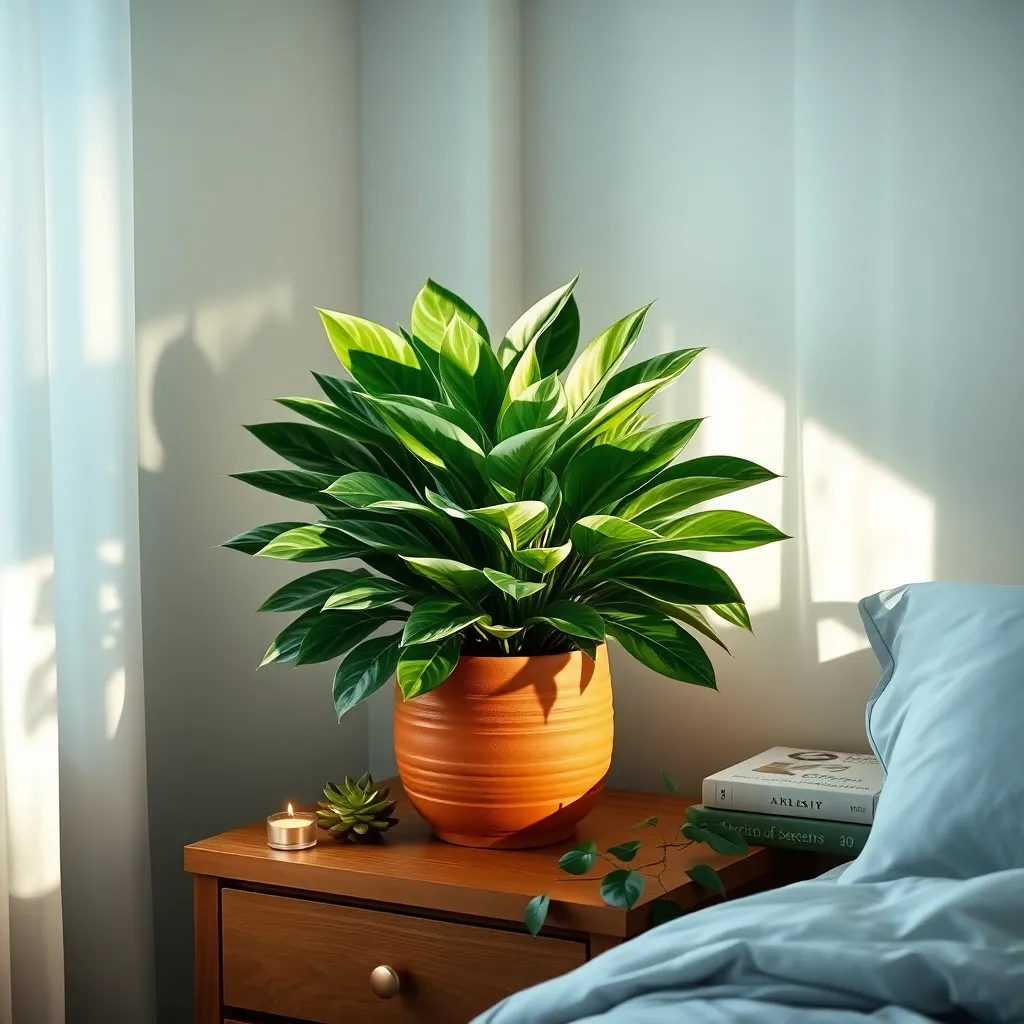
Chinese Evergreen (Aglaonema commutatum) is a perfect choice for bedroom spaces due to its resilience and air-purifying qualities. This plant thrives in low to medium light conditions, making it suitable for rooms with limited sunlight.
To ensure healthy growth, water your Chinese Evergreen when the top inch of soil feels dry. Overwatering can lead to root rot, so it’s better to err on the side of underwatering rather than keeping the soil constantly moist.
For optimal growth, use a well-draining potting mix with equal parts peat, perlite, and sand. This combination helps maintain the right moisture balance and prevents the roots from becoming waterlogged.
While Chinese Evergreens are generally low-maintenance, they benefit from occasional feeding. Apply a balanced liquid fertilizer every two months during the growing season, but reduce feeding in the winter months when the plant’s growth slows down.
Conclusion: Growing Success with These Plants
In exploring the best indoor plants for your bedroom, we’ve uncovered five vital relationship concepts: enhancing communication through shared activities like plant care, fostering emotional well-being with nature’s calming influence, nurturing mutual growth by learning together, creating a peaceful environment to encourage deeper connection, and demonstrating commitment through the sustained care of your leafy companions. These ideas remind us how simple actions can cultivate deeper bonds.
As a practical next step, consider selecting a plant together this weekend, allowing it to symbolize your shared journey. Whether it’s the resilient snake plant or the purifying peace lily, choosing and caring for a plant can be a delightful, ongoing project that enriches your relationship.
Remember to save or bookmark this article for future inspiration and guidance. Each visit can renew your commitment to creating a nurturing environment for both your plants and your partnership.
Looking ahead, by integrating these green companions into your living space, you’re not just beautifying your home; you’re laying the groundwork for a thriving relationship. Embrace this opportunity to grow together, fostering a love that blooms as beautifully as your indoor garden.

